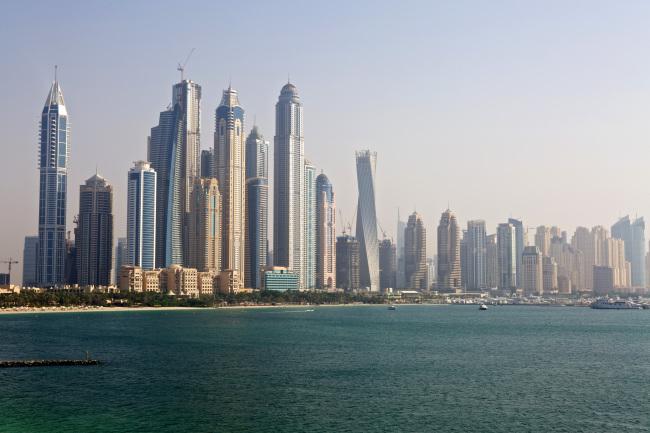Alongside the Dubai Mall, one of the world’s largest shopping centers, sits an ersatz version of what would be an authentic retail experience in most Persian Gulf cities: an Arab souk.
If, in the evening, you stroll through this air-conditioned, hassle- and haggle-free caricature of a market, staffed mostly by smiling South Asians, you can amble out onto the shores of man-made Burj Khalifa Lake, named after the world’s tallest building, which looms over it.
Here ― bumping elbows with a veritable United Nations General Assembly of residents and tourists decked out in everything from dishdashas to Dior ― you can gawk at the Dubai Fountain, Bloomberg Markets magazine will report in its December issue. Every half-hour, an array of computer-choreographed nozzles sends jets of water erupting from the lake’s surface 500 feet into the air, gyrating to Middle Eastern pop one minute and Andrea Bocelli singing “Con Te Partiro” the next.
If, in the evening, you stroll through this air-conditioned, hassle- and haggle-free caricature of a market, staffed mostly by smiling South Asians, you can amble out onto the shores of man-made Burj Khalifa Lake, named after the world’s tallest building, which looms over it.
Here ― bumping elbows with a veritable United Nations General Assembly of residents and tourists decked out in everything from dishdashas to Dior ― you can gawk at the Dubai Fountain, Bloomberg Markets magazine will report in its December issue. Every half-hour, an array of computer-choreographed nozzles sends jets of water erupting from the lake’s surface 500 feet into the air, gyrating to Middle Eastern pop one minute and Andrea Bocelli singing “Con Te Partiro” the next.

Awash in fantasia, this metropolis of glass and steel sprouting from the barren sands of the Arabian Peninsula often seems nothing more than an illusion born of desert heat.
Never was Dubai more miragelike than five years ago, after the global financial crisis crushed what had been a bastion of wealth and growth. House prices plunged as much as 60 percent. Half of the city’s $582 billion in construction projects were either placed on hold or abandoned, their incomplete steel skeletons left poking from the sand, a 21st-century Ozymandias.
Now, Dubai is booming again.
To understand why, journey 32 kilometers from the Dubai Mall to a part of the city few tourists ever see.
Here, if you pass through the security gates at Jebel Ali port, you’re treated to another mesmerizing mechanical ballet ― one less ephemeral and arguably more important to the city-state’s fate than the Dubai Fountain’s dancing waters.
Towering gantry cranes sidle up to 365-meter-long container ships bound for Mumbai or Singapore or Rotterdam. They delicately pluck containers from the tarmac, hoist them into the air in a single, fluid motion and stack them like children’s blocks onto ship decks.
The port is a crucial pillar in the efforts of Dubai’s ruler, Sheikh Mohammed bin Rashid Al Maktoum, to ensure that this time around, growth rests on a more stable footing: moving away from real estate and leaning instead on trade and shipping as well as finance and tourism. (Bloomberg)
-
Articles by Korea Herald


![[Exclusive] Korean military set to ban iPhones over 'security' concerns](http://res.heraldm.com/phpwas/restmb_idxmake.php?idx=644&simg=/content/image/2024/04/23/20240423050599_0.jpg&u=20240423183955)




![[Pressure points] Leggings in public: Fashion statement or social faux pas?](http://res.heraldm.com/phpwas/restmb_idxmake.php?idx=644&simg=/content/image/2024/04/23/20240423050669_0.jpg&u=)



![[Herald Interview] 'Amid aging population, Korea to invite more young professionals from overseas'](http://res.heraldm.com/phpwas/restmb_idxmake.php?idx=644&simg=/content/image/2024/04/24/20240424050844_0.jpg&u=20240424200058)







